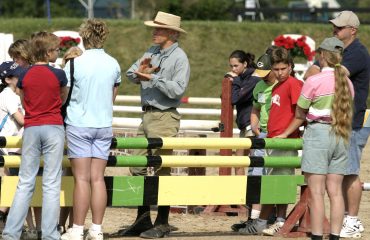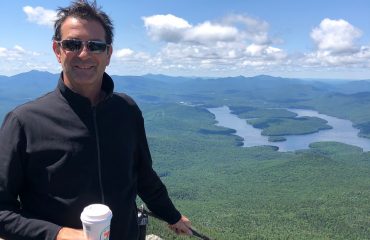
By Laura Scaletti
Portraits by Melissa Fuller
The entirety of Philip Richter’s life has revolved around horsepower—both with equines and internal combustion engines. “I’ve never known a life without horses in it, and they play an integral part in who you are as a human being and, frankly, how you conduct yourself in this world. If you’ve spent any time with horses, particularly from an early age, you have a very different view of things like compassion, patience, resilience and persistence,” Philip said. “Horses have taught me a lot of soft skills that translate into critical life skills that enable one to succeed in anything they do, whether it’s relationships, business, hobbies or friendships.”
It came as no surprise that Philip rode from an early age: He grew up on his family’s Coker Farm, where equestrian legends were made through the generosity and tutelage of his mother, Judy Richter, who passed away in 2022. However, Philip’s equestrian career almost ended before it really went anywhere when, at 6 years old, Philip was riding a pony that ran away with him and galloped five laps around the ring, eventually throwing Philip into a fence.
“I shattered my left arm. It’s a miracle I still ride today because of the trauma. However, because of the aura of horses, I was drawn back to riding and stayed with it, despite my setback,” Philip said.

Philip on Frosty Lad, at Lake Placid in 1979. Philip is now the chairman of the Lake Placid Horse Show. Photo courtesy of Philip Richter
Judy helped lure Philip back to horses with the help of a bomb-proof pony, Frosty Lad. “I felt safe on him, bonded with him and rebuilt my relationship with horses because of Frosty,” Philip said.
Thanks to Frosty, today Philip shows in the High Amateur Jumpers and has taken over running the family’s Coker Farm. When not at the barn or running his Hollow Brook Wealth Management firm, Philip can be found with his collector cars and motorcycles. Biennially, Coker Farm plays host to Philip’s Turtle Invitational, which brings together spectacular vehicles and hundreds of passionate enthusiasts for a weekend full of camaraderie: the opportunity to reconnect with old friends and make new ones.
Family Legacy
With Philip’s parents and his maternal grandparents both meeting via horses, the horse-loving gene runs strong amongst the Hofmanns and Richters. “My grandparents actually met each other on horseback in Kansas City at a riding club called Saddle and Sirloin in the 1930s. Horses were always part of their lives. My grandfather had jumpers and foxhunters, and in his later years he drove four-in-hand carriages and even got into racehorses,” Philip said. “He was on the board of the USET and very involved with the Essex Foxhounds.”

Philip, in 1976, at the Cape Cod Horse Show, riding Johnny’s Pocket with his mom, Judy Richter. Photo courtesy of Philip Richter
Philip’s mother, Judy, and her sister Carol grew up immersed in horses. Both sisters would go on to be successful riders and trainers, with Carol riding for the USET. While Judy worked hard to take care of the horses on the family’s Windy Acres farm in New Jersey, Philip’s father, Max, was growing up in Germany in the midst of World War II.
“All of the family history culminated in my mom and dad meeting at the National Horse Show in Madison Square Garden and, that’s where they were first introduced,” Philip said. Thankfully for Philip, Judy and Max shared their common love of horses with him.
Throughout the years, Judy and Philip truly bonded over their passion for equestrian sport. When Philip was 10 years old, he experienced one of his most memorable moments with his mom. “I came home from school one day in 1980 and my mom was just crying inconsolably. I thought a terrible tragedy had happened to a family member. It turned out, on that day President Carter announced that the United States would be boycotting the summer Olympics in Moscow because of the Cold War,” Philip said. “We had a horse, Johnny’s Pocket, that had qualified to go to the Olympics with Norman Dello Joio.”
That shared moment with his mom widened Philip’s worldview, leading him to better understand how all-encompassing geopolitics and its ramifications can be. “For my mom, it was her life’s work to get a horse qualified for the Olympics. She achieved that only to be blocked from going by the politics of the moment,” he said. Philip would eventually have a full-circle moment with Johnny’s Pocket when he showed him in the Junior jumpers at the end of his career.
Going Clear
It didn’t take long for Philip to gravitate towards the jumper ring. “I did the requisite time in the pony ring and there was an attempt to get me to qualify for equitation finals, but I never really had a passion for that,” he said. “I truly love the jumper ring.”

Philp and Escapade H at the Winter Equestrian Festival in 2023. Photo by Four Oaks
Philip’s favorite part of show jumping is the pursuit of a clear round. “What makes the jumpers unique is the sense that you can make certain mistakes and still have a shot at winning the class, unlike hunters,” he said. “On the other hand, as the jumps get bigger, the margin of safety is more defined and your mistakes have to be smaller in order to succeed.”
Making the jump-off is the ultimate source of fun for Philip, when it’s just him, his partner, a shortened course and the clock. Regardless of what the course is, Philip tries to get into the mind of the course designer to try and figure out what questions the course is asking. “I always look at the course and try to dissect and interpret what is being asked of horse and rider. I wonder, What jump will be the one trap? Sometimes it’s the plain brown oxer that’s going to get you, rather than the really tall plank that’s sitting in flat cups,” Philip said. “I formulate a plan and ride my horse the best I can according to that plan.”
Philip has been fortunate to have Norman Dello Joio by his side for decades as his trainer. He also rode with Michael Matz for five years, when Norman had a private job in the ’90s. “They both infused in me a level of optimism, confidence and a healthy respect for the difficulty of equestrian show jumping,” he said. “Of course, fundamentals matter; but at the end of the day, details really matter.”
In addition to working with arguably two of the greatest show jumpers in the modern era, Philip relies on observation to learn more about the sport. “I’m a big believer in observation—in learning by walking around. You can learn from anybody, even if that’s what not to do,” Philip said. “I was lucky to grow up in an era watching Rodney Jenkins, Buddy Brown, Anne Kursinski, Barney Ward, Leslie Burr, Joe Fargis and Katie Monahan Prudent, who were all riding phenoms.”
During legendary rider Bill Steinkraus’ final years, Bill would review Philip’s horse-show videos and provide feedback. “It was a good thing for both of us. It allowed Bill to stay active in the sport in his 90s and share his knowledge with me,” Philip said.
Lake Placid
Lake Placid has always held a special place for the Richter family. “My mom started showing there after it was established in the early ’70s. I grew up showing there with ponies, later with my Junior jumpers and now with my Amateur jumpers,” Philip said. “It’s an incredible place to have a horse show as it’s just a beautiful part of the world.”

Not only is it a beautiful part of the world, but it’s also where memories are made. Philip was on hand at the 1980 Winter Olympics when the American hockey team defeated the Russians during the “Miracle on Ice” game.
“Ronnie Mutch used to say, ‘Good things always happen in Lake Placid because you’re closer to the stars,’” Philip said. For the past 20 years, Philip has been part of the magic that is the Lake Placid Horse Show, as he’s been part of the board and is now the chairman.
The previous chairman, Richard Feldman, personally asked Philip to take over the role. “Although my title is chairman, it’s not just me making decisions to put on this amazing event. We have a great team that works together to make it happen. We all make decisions together to make the event the best it can be,” he said.
As the industry trends to more multiweek competitions, it’s getting increasingly difficult to run boutique competitions. However, thanks to the support of the local community, Lake Placid is able to remain competitive with other venues. “Our show has the single biggest economic impact to Lake Placid,” he said.
Through being chairman of Lake Placid and serving as treasurer of the Hampton Classic, Philip has become a more tolerant competitor when acts of God or other circumstances cause things to go awry at venues where he’s competing. “In a post-pandemic world, it’s really difficult to find people to work horse shows, not to mention having pride, skill and care about the work they’re doing,” he said. “I always want to compete at a good event at a good venue; however, after standing in those shoes, I realize it’s not always as easy as it appears to put on a quality event.”
Working Amateur
Philip is the president and co-founder of New York-based Hollow Brook Wealth Management, LLC, which he runs with business partner and fellow equestrian Alan Bazaar. With a demanding job that keeps Philip busy much of the work week, he doesn’t get out to the barn as much as he would like. “Given my work schedule, I can’t show every weekend. I can’t chase all the horse shows. I need a horse that has experience, is competitive and just needs to stay fit,” he said.
 Philip admits it’s not easy being a working amateur. For him, it really matters what he’s sitting on. “I only ride horses that have a lot of experience. I need horses that can take a joke, because I’m prone to making mistakes. I also like to ride horses that have experience far in excess of what I would be showing them in,” he said. “If it hasn’t shown at Hickstead, Aachen or that level, I don’t want to ride it in the 1.45m High Amateurs. I’m happy to buy a horse that’s 14 to 17 and is on its way down from the Grand Prix level.”
Philip admits it’s not easy being a working amateur. For him, it really matters what he’s sitting on. “I only ride horses that have a lot of experience. I need horses that can take a joke, because I’m prone to making mistakes. I also like to ride horses that have experience far in excess of what I would be showing them in,” he said. “If it hasn’t shown at Hickstead, Aachen or that level, I don’t want to ride it in the 1.45m High Amateurs. I’m happy to buy a horse that’s 14 to 17 and is on its way down from the Grand Prix level.”
It’s not just a matter of choosing the right horses, it’s also about the team supporting Philip. “The program at Wembley Farm, with Norman and Nick, supports my lack of practice by always having my horses set up properly for me. There is always a professional riding my horse. Nick usually does a warmup class on Wednesday to prep my horses for the weekend,” Philip said. “Horse preparation and having a ground team who can support that is vital.”
Philip encourages other working amateurs to stay focused and compete for the enjoyment of the sport and the horse. “If you’re consistent enough in your preparation, sometimes the door gets left open and you have the opportunity to squeak through. Earlier this season, I won a 1.45m Hall of Fame class at WEF. It was the first time all season they split the class by age,” he said. “It was the first time in my life that being 53 was an advantage, but my persistence and consistency paid off in a win.”
Turtle Garage
Growing up on Coker Farm, Philip had a Honda minibike at age 6 and zoomed all around the farm on it. As a result of that early feeling of exhilaration and independence, he became enthralled with the miracle of the internal combustion engine.
“I used to take it apart, put it back together and tinker with it. In college, I bought my first BMW street motorcycle and rode it to school,” Philip said. “I got into global touring and rode my motorcycle all over the world, from Turkey to New Zealand, Italy and more.”
Philip got interested in cars as his best friend’s father owned the local Porshe/Audi/Volkswagen dealership. Unfortunately, Philip’s best friend died tragically in an automobile accident at age 16. “Afterward, I became very close with his dad, Malcolm Pray Jr., who had a huge collection of rare cars. We used to take them to car shows all around the world,” Philip said.

Once Philip had some disposable income of his own, he began buying his own collector cars and showing them himself. “Today I write for a widely read car collector magazine, Sports Car Market, I speak on panels at the biggest car shows in the country and show my cars at a variety of shows,” he said. “I recently joined the board of the Revs Institute, which is home to one of the finest car collections in the world and is the leading research and education center in the field of historical and meaningful automobiles. When I age out of being able to show competitively, I think car shows will be something I can do forever.”
Part of what draws Philip to the car show circuit is the people. Much like those involved in equestrian pursuits, car collectors are passionate about their hobby. “The people who collect cars at the highest level are really interesting people,” Philip said.
Supporting the Sport
As Philip looks toward the future, he’s excited about the fact that Americans are finally starting to understand the uniqueness and legitimacy of equestrian sport.

“The public has started to realize that it’s an incredible sport where women and men compete on equal turf. Like people, horses can have good days and bad days. Show jumping shares aspects with other popular team sports; however, the dynamic element of the horse is distinctly different from football, hockey or Formula 1,” he said. “Our sport is growing, and we’re really starting to see people outside of our industry get interested in show jumping.”
Philip is doing his part to help the sport grow as he is on the USEF’s board of directors for the USET Foundation and is the treasurer for USET. “I think I have a fiduciary duty to give back and provide what expertise I can bring to the table for these two organizations to succeed,” Philip said.
While working on behalf of fellow equestrians, Philip is also hard at work at Hollow Brook. “I’ve got my head down trying to build a boutique wealth management firm of excellence. I’ve surrounded myself with smart people who are passionate about business and dedicated to providing our clients with service levels that no longer exist in this world,” Philip said.
Part of why Philip wants the sport to succeed is because of the enjoyment it brings him. Currently competing his own Escapade H and Giovannie in the High Amateurs, Philip has big goals for his horses and himself this coming season. “I hope to show Escapade in a two-star Grand Prix this summer and will marry my fiancé Kyle Olson in October,” he said. Both in and out of the show ring, Philip is doing his part in continuing the family legacy.
For more information, visit turtlegarage.com
Thanks to GT Motorcars LLC in West Palm Beach, Florida, for the cars used in the photoshoot.
Photos by Melissa Fuller, melissafullerphotography33.mypixieset.com, unless noted otherwise












